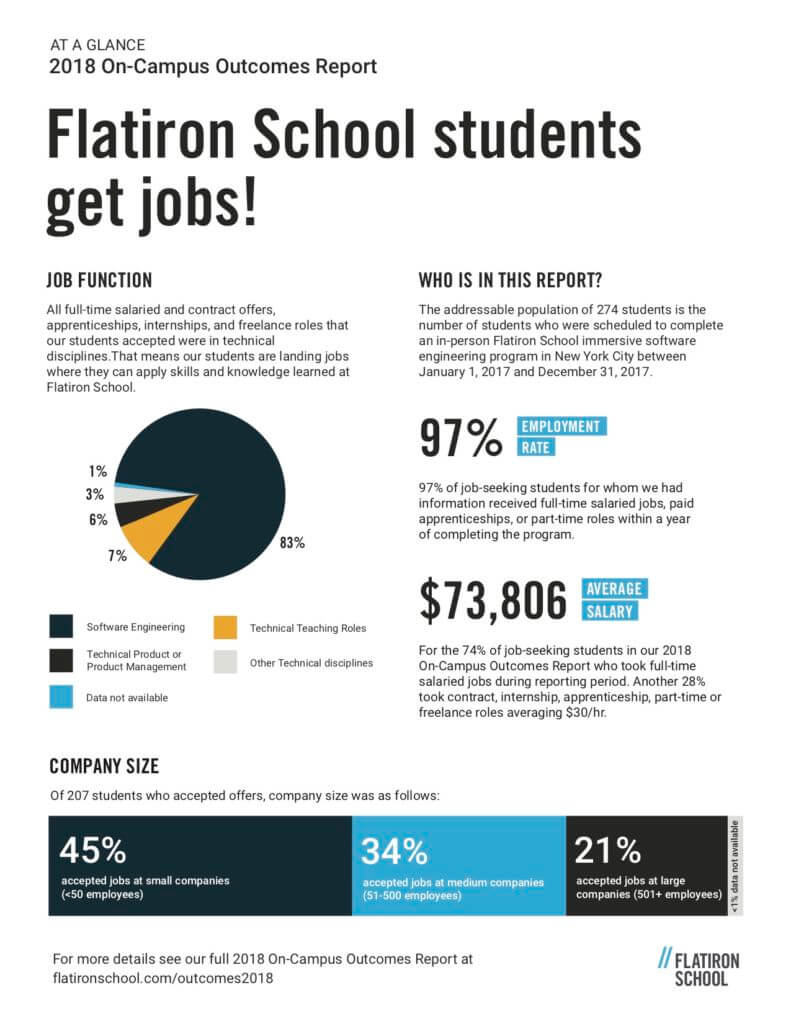How Flatiron School’s Teachers Combine Expertise and Passion to Make Learning to Code Accessible
By:Dedication, passion, and expertise
Teachers provide guidance, feedback, and training, and set clear expectations. Across our in-person and online campuses, our passionate, committed teachers help students change their lives through tech, according to Sean Dagony-Clark, Director of Teacher Training at Flatiron School. Arriving at Flatiron School after 14 years in traditional education, Sean was impressed by the quality and commitment of Flatiron School’s instructors. “The teachers care so deeply about how their students do, and they get emotionally affected when the student struggles,” Sean says.Our teachers represent the very best the tech industry has to offer. Soundarya R., for example, was leading a team of developers at Microsoft before becoming the Lead Software Engineering Instructor at Flatiron School Seattle. Soundarya calls teaching her “main passion” and says seeing students grow is the most rewarding part of being a teacher. “I chose Flatiron School specifically, since we are geared towards helping everyone make huge career changes and shifts in their lives,” she says. Our teachers are experts and good teachers who are always striving to improve. “There’s genuine interest in becoming better at teaching,” Sean says. Fangfang L., Lead Data Science Instructor at our flagship NYC campus, says the feedback she received from students has helped her become a better teacher, by highlighting her strengths and areas for improvement. Great teachers combined with a great curriculum lead to great jobs outcomes. That’s why our teachers succeed in the classroom and why our students go on to become successful software engineers, data scientists, and designers.
In the classroom
Teaching students to code can be challenging. Our approach harnesses the power of “scaffolded learning” - helping students make connections between what they already know and the new content they need to learn. Instead of diving deep into coding, we first immerse students in Ruby. Ruby is relatively approachable, according to Sean. “The error messages in Ruby, for example, make more sense than error messages in JavaScript.” Students can quickly start building meaningful things in Ruby, see the power of a coding language, and experience the sense of accomplishment that comes with creating something with code. With Ruby, students learn the fundamentals of coding that they can apply to new languages that they’ll learn over the course of 15 weeks. “You already know the basics. All the same rules apply but it’s just different syntax,” Sean says. This journey from Ruby to JavaScript is scaffolded learning in action.
Gamifying learning
A good video game teaches you as you play.We apply this principle to make learning to code engaging and accessible. Once students see the potential of code, Flatiron School has built-in support systems that help them maintain excitement. One way to do that is by “gamifying” the learning experience. Gamification applies principles from video games to other subjects. For example, a video game teaches you the rules and how to complete levels while you’re playing, via a tutorial or previous levels of the game. Maybe you learn how to jump or how a newly introduced tool can be used to solve a puzzle. Completing a level is a satisfying experience that makes you want to keep playing. Those strategies can be applied to teaching how to code. Avi Flombaum, our co-founder, built Learn.co, our educational platform, with that idea in mind. In a game, for example, you might fail to complete a level, but instead of starting over at the very beginning, the game lets you continue from a location near where you failed. This allows you to focus specifically on where the problem occurred. We take that approach when debugging code. If something goes wrong in your code, Learn.co highlights the area where the error occurred. Students know that there’s something wrong and it’s up to them to figure it out and debug their code. Fixing the error allows you to move on to the next lesson or section of code. When students complete a lesson, there’s a sense of accomplishment. What excites Sean the most about Learn.co is the personalized pacing — students can complete our courses at their own pace and completely on their own, but with built-in tools that provide support and reinforcement, and track progress along the way.
Education rooted in jobs outcomes
We get students jobs through great teachers, an approachable curriculum, and an innovative education platform in Learn.co. Flatiron School succeeds when our students succeed. That’s why we were the first coding bootcamp to release independently verified jobs outcomes reports. You can find the latest outcomes for our immersive Software Engineering program at our flagship NYC campus below. For more information about them, to understand how they were calculated, or to see the rest of our results, simply view our Jobs Reports. We’re proud to have helped over 1,000 students start careers as software engineers, data scientists, and UX/UI designers. But our work is far from over.

The school of the future
Flatiron School’s curriculum team and teacher training team are always working on new ways to connect with students. Our campus is your home, community, and investment. Learn.co, for example, will continue to evolve to better support students. That could include better reinforcement tools or easier ways to get support. Pedagogy is also evolving, and we apply new principles to make the bootcamp experience more rewarding for students. If you want to learn more, you can schedule a call with the Flatiron School admissions team. They would love to hear from you.
This post was sponsored by Flatiron School. To learn more about Flatiron, visit flatironschool.com or check out their reviews on SwitchUp.

